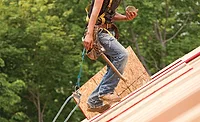BLS Report Shows Roofing Fatalities Up by 15% in 2019

Image by Russell Holden from Pixabay.
Fatalities in the roofing industry only worsened in 2019, according to numbers released this month by the U.S. Bureau of Labor Statistics (BLS).
In its newest National Census of Fatal Occupational Injuries report, the data shows roofers accounted for 111 of the 5,333 fatal injuries that occurred in 2019. This is up 15% from 2018’s figure of 96.
BLS’ report shows this is a fatal injury rate of 54 per 100,000 workers, up from 51.5 — an increase of nearly 5%. The average rate across all occupations is 3.5, meaning roofing’s fatality rate is roughly 15 times higher than the average.
Only three other occupations have a higher fatality rate than roofing, which include: fishing and hunting (145), logging (68.9) and aircraft pilots and flight engineers (61.8).
By comparison, fatal injuries among police and sheriff’s patrol officers was 11.1 in 2019, which is a decrease from 2018’s rate of 13.7.
Tom Shanahan, vice president of enterprise risk management and executive education with the National Roofing Contractors Association (NRCA), said the information is certainly troubling, but it might be even worse. He notes the BLS report doesn’t contain information about fatalities for businesses under the NAICS code representing roofing businesses or contractors.
“The occupation of ‘roofers’ comprises a large portion of occupations in the roofing industry and the reporting of those fatalities is significant, yet causes us to inquire what are the total deaths experienced in all roofing occupations — that is, all roofing contractors’ employees,” said Shanahan. “So, regrettably, that number isn’t presented and is certainly greater.”
Preventing Disaster
In roofing, the most common cause of injuries and deaths are fall-related incidents, and is the most cited OSHA violation. According to BLS, 93 of the 111 roofing fatalities were caused by a fall, slip or trip incident. In total, 880 of the deaths in 2019 were due to a fall, slip or trip, an 11% increase from 791.
Shanahan said the roofing industry needs to increase its efforts in being more thorough in assessing jobs when bidding and planning for fall protection. By doing this, along with daily job hazards analyses, he believes the industry will help build awareness in areas like understanding deck integrity, housekeeping and accessing vulnerabilities.
“What we also know and have been concerned about for years is the effect, in particular the residential reroofing market, of the underground economy,” he said. “It is here where talk of training and job hazard analysis, in particular, is not occurring. Those realities are a key reason NRCA participates in activities aimed at the smallest contractors, who need free and easy-access safety support.”
To that end, the NRCA’s “Serving Up Safety: A Recipe for Avoiding Falls on the Job” program assists in educating and training workers on fall prevention. The NRCA also partners with CNA Insurance to sponsor the largest business insurance program for roofing contractors.
"Providing regular training and auditing jobsites to ensure compliance with the critical work practices workers must follow is essential to reducing roofing industry fatalities," he said.
The construction industry as a whole suffered 1,061 fatal injuries for the year, a 6% increase from 2018 and the industry’s highest number of worker deaths since 2007.
The number of fatal work injuries in the U.S. increased from 5,250 in 2018 to 5,333 in 2019, a 1.5% increase. Since the information is from 2019, the BLS made no changes in its data collection to account for COVID-19.
Looking for a reprint of this article?
From high-res PDFs to custom plaques, order your copy today!






